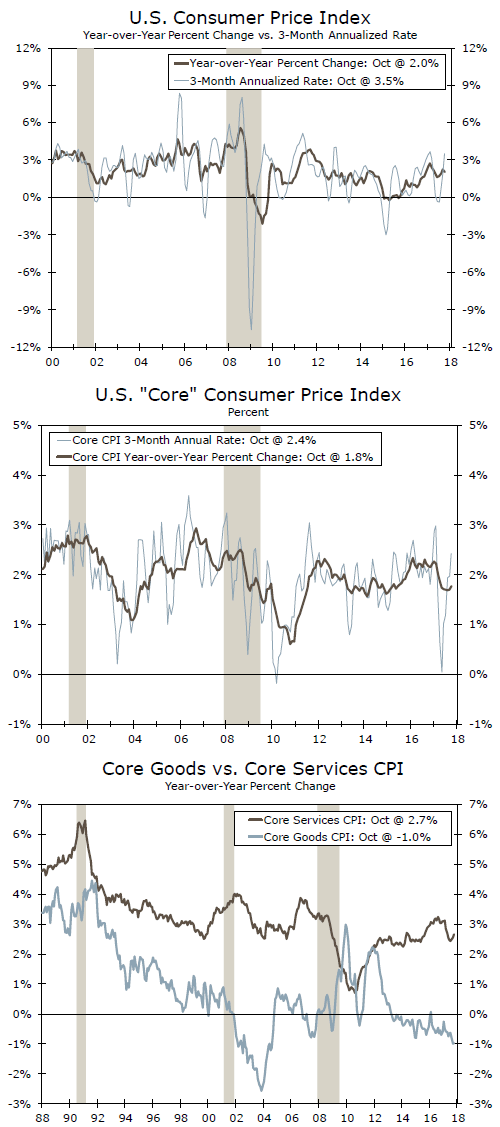Consumer price inflation rose more slowly in October due to a pullback in energy prices, but core inflation picked up. Reflation increasingly looks to be back on track which will support further Fed tightening.
Soft Headline, but Core Inflation Is Strengthening
Inflation was toned down in October with the Consumer Price Index increasing 0.1 percent after two months of 0.4 percent-plus gains. The yearover- year rate subsequently edged back down to 2.0 percent. The slowdown reflected a decline in energy prices as the supply disruptions surrounding Hurricanes Harvey and Irma abated. Gasoline prices fell 2.4 percent over the month, more than offsetting increases for electricity and gas services. Food prices were flat in October and have continued to increase more slowly than other items over the past year, up 1.3 percent.
Excluding food and energy, inflation was noticeably stronger. The core index rose a "high" 0.2 percent (0.225 percent before rounding). That pushed the year-over-year change up to 1.8 percent. The performance over the past three months is even more impressive; core prices have advanced at a 2.4 percent annualized rate, making the slowdown in inflation earlier this year look increasingly temporary.
Core services have been the primary source of inflation weakness this year, but services prices rose 0.3 percent in October. Gains were broadly based, including shelter, medical care, transportation and even wireless phone services, which were up for a second straight month.
Core goods prices also posted a rare increase. Replacement demand following the recent hurricanes generated some support to used car prices which were up 0.7 percent. However, other categories were also more supportive of inflation – or at least less deflation – including medical goods (non-prescription drugs) and tobacco products.
Reflation Supportive of Fed Tightening Plans, But Will Be Slow
The Fed has struggled this year in determining if the slowdown in core inflation has been due to a confluence of one-offs or more persistent disinflationary forces. We have been of the mindset that the pullback has been due primarily to a few unique factors that look unsustainable. The primary categories holding down core inflation earlier this year – cell phone plans, housing costs and physician services – have all gathered steam in recent months. The pickup clears the way for a December rate hike and supports the case for continued tightening in the year ahead.
The FOMC, however, will be watching the PCE deflator more closely. While much of the early estimates for the PCE deflator are derived from the CPI report, healthcare, which is about twice as important in the PCE deflator, is derived from Producer Price Index (PPI) estimates. Yesterday’s PPI showed healthcare services inflation slipping to 1.2 percent, the smallest 12-month change since the spring of 2016. That should keep the core PCE deflator from swiftly rebounding to the FOMC’s target in the coming months and keep the FOMC on the path of only gradual rate increases.














